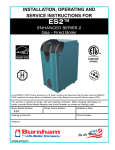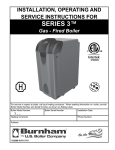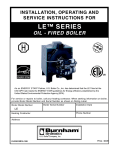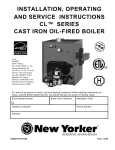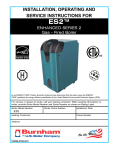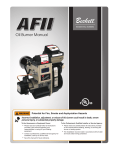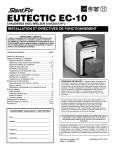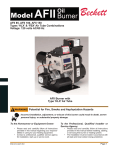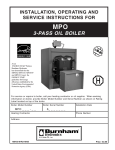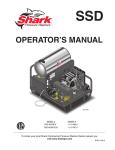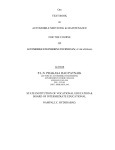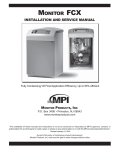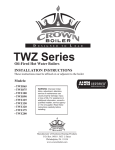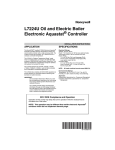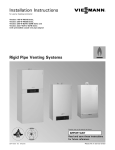Download Burnham 81433101R16-1/10 Boiler User Manual
Transcript
IN S TAL L AT ION , OP E R AT IN G AN D S E R V IC E IN S T R U C T ION S F OR L E ® D V S E R IE S DIRECT VENT OI L - F I R E D BOI L E R As an ENERGY STAR® Partner, Burnham Hydronics has determined that the LEDV1, fired at the 0.60 GPH rate, meets the ENERGY STAR guidelines for Energy efficiency established by the United States Environmental Protection Agency (EPA). F o r s e rvi c e o r r e p a i rs to b o i le r, c a ll yo ur he a ti ng c o ntra c to r. W he n s e e k i ng i nfo rma ti o n o n b o i le r, p ro vi d e B o i le r M o d e l Numb e r a nd S e ri a l Numb e r a s s ho wn o n Ra ti ng L a b e l. B o i le r Mo d e l Num b e r B o i le r S e ri a l Numb e r Ins ta lla ti o n D a te LE D V He a ti ng C o ntra c to r P ho ne Numb e r A d d re s s 81433101R16-1/10 Price - $3.00 IMPORTANT INFORMATION - READ CAREFULLY All boilers must be installed in accordance with National, State and Local Plumbing, Heating and Electrical Codes and the regulations of the serving utilities. These Codes and Regulations may differ from this instruction manual. Authorities having jurisdiction should be consulted before installations are made. In all cases, reference should be made to the following Standards: USA BOILERS A. Current Edition of American National Standard ANSI/NFPA 31, “Installation of Oil Burning Equipment”, for recommended installation practices. B. Current Edition of American National Standard ANSI/NFPA 211, “Chimneys, Fireplaces, Vents, and Solid Fuel Burning Appliances”, For Venting requirements. C. Current Edition of American Society of Mechanical Engineers ASME CSD-1, “Controls and Safety Devices for Automatically Fired Boilers”, for assembly and operations of controls and safety devices. D. All wiring on boilers installed in the USA shall be made in accordance with the National Electrical Code and/or Local Regulations. CANADIAN BOILERS A. Current Edition of Canadian Standards Association CSA B139, “Installation Code for Oil Burning Equipment", for recommended Installation Practices. B. All wiring on boilers installed in Canada shall be made in accordance with the Canadian Electrical Code and/or Local Regulations. The following terms are used throughout this manual to bring attention to the presence of hazards of various risk levels, or to important information concerning product life. DANGER CAUTION Indicates an imminently hazardous situation which, if not avoided, will result in death, serious injury or substantial property damage. Indicates a potentially hazardous situation which, if not avoided, may result in moderate or minor injury or property damage. WARNING NOTICE Indicates a potentially hazardous situation which, if not avoided, could result in death, serious injury or substantial property damage. Indicates special instructions on installation, operation, or maintenance which are important but not related to personal injury hazards. NOTICE This boiler has a limited warranty, a copy of which is printed on the back of this manual. It is the responsibility of the installing contractor to see that all controls are correctly installed and are operating properly when the installation is complete. The warranty for this boiler is valid only if the boiler has been installed, maintained and operated in accordance with these instructions. DANGER DO NOT store or use gasoline or other flammable vapors or liquids in the vicinity of this or any other appliance. If you smell gas vapors, DO NOT try to operate any appliance - DO NOT touch any electrical switch or use any phone in the building. Immediately, call the gas supplier from a remotely located phone. Follow the gas supplier's instructions or if the supplier is unavailable, contact the fire department. WARNING Boiler materials of construction, products of combustion and the fuel contain alumina, silica, heavy metals, carbon monoxide, nitrogen oxides, aldehydes and/or other toxic or harmful substances which can cause death or serious injury and which are known to the state of California to cause cancer, birth defects and other reproductive harm. Always use proper safety clothing, respirators and equipment when servicing or working nearby the boiler. This boiler contains very hot water under high pressures. Do not unscrew any pipe fittings nor attempt to disconnect any components of this boiler without positively assuring the water is cool and has no pressure. Always wear protective clothing and equipment when installing, starting up or servicing this boiler to prevent scald injuries. Do not rely on the pressure and temperature gauges to determine the temperature and pressure of the boiler. This boiler contains components which become very hot when the boiler is operating. Do not touch any components unless they are cool. This boiler must be properly vented and connected to an approved vent system in good condition. Do not operate boiler with the absence of an approved vent system. This boiler needs fresh air for safe operation and must be installed so there are provisions for adequate combustion and ventilation air. The interior of the venting and air intake systems must be inspected and cleaned before the start of the heating season and should be inspected periodically throughout the heating season for any obstructions. Clean and unobstructed venting and air intake systems are necessary to allow noxious fumes that could cause injury or loss of life to vent safely and will contribute toward maintaining the boiler's efficiency. This boiler is supplied with controls which may cause the boiler to shut down and not re-start without service. If damage due to frozen pipes is a possibility, the heating system should not be left unattended in cold weather; or appropriate safeguards and alarms should be installed on the heating system to prevent damage if the boiler is inoperative. This boiler is designed to burn No. 2 fuel oil only. Do not use gasoline, crankcase drainings, or any oil containing gasoline. Never burn garbage or paper in this boiler. Do not convert to any solid fuel (i.e. wood, coal). Do not convert to any gaseous fuel (i.e. natural gas, LP/propane). All flammable debris, rags, paper, wood scraps, etc., should be kept clear of the boiler at all times. Keep the boiler area clean and free of fire hazards. All boilers equipped with burner swing door have a potential hazard which if ignored can cause severe property damage, personal injury or loss of life. Before opening swing door, turn off service switch to boiler and disconnect two halves of Burner Swing Door Interlock wiring harness to prevent accidental firing of burner outside the combustion chamber. Be sure to tighten swing door fastener completely and reconnect two halves of Burner Swing Door Interlock when service is completed. WARNING Improper installation, adjustment, alteration, service or maintenance can cause property damage, personal injury or loss of life. Failure to follow all instructions in the proper order can cause personal injury or death. Read and understand all instructions, including all those contained in component manufacturers manuals which are provided with the appliance before installing, starting-up, operating, maintaining or servicing this appliance. Keep this manual and literature in legible condition and posted near appliance for reference by owner and service technician. This boiler requires regular maintenance and service to operate safely. Follow the instructions contained in this manual. Installation, maintenance, and service must be performed only by an experienced, skilled and knowledgeable installer or service agency. All heating systems should be designed by competent contractors and only persons knowledgeable in the layout and installation of hydronic heating systems should attempt installation of any boiler. Installation is not complete unless a pressure relief valve is installed into the tapping located on top of appliance - See Water Piping and Trim Section of this manual for details. It is the responsibility of the installing contractor to see that all controls are correctly installed and are operating properly when the installation is completed. This boiler is suitable for installation on combustible flooring. Do not install boiler on carpeting. Do not tamper with or alter the boiler or controls. Inspect flueways at least once a year - preferably at the start of the heating season. The inside of the combustion chamber, the vent system and boiler flueways should be cleaned if soot or scale has accumulated. Oil Burner and Controls must be checked at least once a year or as may be necessitated. Do not operate unit with jumpered or absent controls or safety devices. Do not operate unit if any control, switch, component, or device has been subject to water. Table of Contents I. Pre-Installation.............................................................6 II. Unpack Boiler...............................................................7 III. Water Piping and Trim..................................................9 IV. Venting/Air Intake Piping...........................................12 V. Electrical and Sequence of Operations........................18 VI. Oil Piping...................................................................21 VII. System Start-up...........................................................23 VIII. Service and Cleaning...................................................29 IX. Repair Parts................................................................32 X. Appendix Low Water Cut Off......................................................39 Figure 1: LEDV Packaged Boiler Water Content: 6.1 gallons I. Pre-Installation A. INSPECT SHIPMENT carefully for any signs of damage. 1. ALL EQUIPMENT is carefully manufactured, inspected and packed. Our responsibility ceases upon delivery of crated boiler to the carrier in good condition. 2. ANY CLAIMS for damage or shortage in shipment must be filed immediately against the carrier by the consignee. No claims for variances from, or shortage in orders, will be allowed by the manufacturer unless presented within sixty (60) days after receipt of goods. B. LOCATE BOILER in front of final position before removing crate. See Figure 1. Boiler's approximate shipping weight is 325 pounds. 1. LOCATE so that vent pipe will be short and direct. Refer to Section V. A., General Venting Guidelines. 2. BOILER IS SUITABLE FOR INSTALLATION ON COMBUSTIBLE FLOOR. Boiler cannot be installed on carpeting. 3. FOR BASEMENT INSTALLATION, provide a solid base, such as concrete, if floor is not level, or if water may be encountered on floor around boiler. 4. PROVIDE SERVICE CLEARANCE of at least 24” at front of boiler for servicing. 5. For minimum clearances to combustible materials, see Figure 2. C. PROVIDE COMBUSTION AIR SUPPLY to accommodate proper combustion of oil. Local and national codes may apply and should be referenced. 1. In unconfined spaces (basement) in buildings of conventional frame, brick, or stone construction, infiltration normally is adequate to provide air for combustion. An unconfined space is a space whose volume is greater than or equal to 50 cubic feet per 1000 BTUH of the combined input of all air consuming appliances in the space. 2. In a confined space, combustion air may be ducted directly from the outdoors to the burner. Refer to Section IV for installation of air intake duct to the burner. D. VENTILATION AIR must be provided to maintain the ambient temperature at safe limits. Local and national codes may apply and should be referenced. 1. In unconfined spaces (basement) in buildings of conventional frame, brick, or stone construction, infiltration normally is adequate to provide air for ventilation. 2. In confined spaces (closet, etc.) two permanent openings, one near the top of the enclosure and one near the bottom, shall be provided. Each opening shall have a free area of not less than 1 sq. inch per 1000 BTUH of the total input of all appliances in the space. E. Do not install boiler where gasoline or other flammable vapors or liquids, or sources of hydrocarbons (i.e. bleaches, cleaners, chemicals, sprays, paint removers, fabric softeners, etc.) are used or stored. II. Unpack Boiler CAUTION Do not drop boiler. Do not bump boiler jacket against floor. A. REMOVE CRATE 1. Remove all fasteners at crate skid. 2. Lift outside container and remove all other inside protective spacers and bracing. Remove vacuum relief valve and miscellaneous trim bag containing safety/relief valve, and pipe fittings. B. REMOVAL OF BOILER FROM SKID 1. Boiler is secured to base with 2 bolts, 1 at left front and 1 at right rear. Remove both bolts. 2. Tilt boiler, "walk" boiler backward, and set rear legs down on floor. Tilt boiler backward, pull skid forward and set front legs down on edge of skid. Install close nipple, tee, and plug in return coupling. See Section III and Figure 5. Point tee toward permanent return location. 3. Tilt boiler backward and remove skid. Be careful not to damage Burner or Jacket. C. DETERMINE PROPER HINGE LOCATION FOR BURNER SWING DOOR. Boiler is shipped with hinges on left side. Approximately 12 inches are required on the hinge side for burner clearance. If there will be less than 12 inches from left side of boiler to wall, move hinges to right side (refer to Paragraph D). D. HINGE LOCATION CHANGE (if required) (refer to Figure 3). 1. Pull 2 halves of Burner Swing Door Interlock apart. Swing Door Interlock is connected to T-T terminals on R7184P Control. Lift Honeywell R7184P Control off of Burner Junction Box and disconnect wiring harness from burner. 2. Remove 8 sheet metal screws from jacket. Remove rear jacket box and bend both sides of Jacket Wrapper up, see Figure 22. 3. Remove 2 (two) 5/16" - 18 x 3" long hex head cap screws and flat washers from right side of door. Remove 2 hairpin cotter pins and 2 hinge pins from hinges on left side of door and remove Door Assembly from boiler. Inspect Front and Rear Door Insulation Pieces and Combustion Chamber Liner, see Paragraph G. 4. Remove 4 hex nuts from bolts that attach hinges and hinge spacers to left side of Tubesheet. Remove 4 hex head cap screws that attach hinges to door. 5. Attach 2 hinge brackets & spacers to Tubesheet and 2 hinge brackets to Door on right side of boiler. 3 Holes in each Hinge Bracket must line up with 3 matching holes in Spacer, Tubesheet or Door. See Figure 3. Tighten hex nuts, bolts and screws by hand only. 6. Replace door assembly. Hinge brackets attached to door must rest on top of hinge brackets attached to tubesheet. See Figure 3. Slide hinge pins through hinges from top and install cotter pins. Close door and install 5/16" - 18 x 3" long hex head cap screws through flat washers and left side of door and into tapped holes in tubesheet. Tighten all hex nuts, bolts and screws. When door is installed properly, it is parallel to Tubesheet when viewed from top and sides. 7. Bend sides of Jacket Wrapper down and attach 2 Jacket Straps to 4 slots at bottom of Jacket Wrapper sides with sheet metal screws. Install Rear Jacket Box with 4 sheet metal screws. See Figure 22. 8. Connect wiring harness to burner Junction Box and install Honeywell R7184P Control, see Wiring Diagram, Figure 15 or 15A. Reconnect Swing Door Interlock. E. INSTALL BOILER CONTROL. 1. Pull bulb and capillary tube out of hole in back of control. Insert bulb in immersion well on top of boiler and secure control with set screw in control. 2. Secure flexible conduit to Jacket Wrapper side with conduit clamp and sheet metal screw. Conduit must be on same side of boiler as Swing Door hinges. F. MOVE BOILER TO PERMANENT POSITION by sliding or walking. G. INSPECT FRONT AND REAR DOOR INSULATION AND COMBUSTION CHAMBER LINER 1. OPEN BURNER SWING DOOR on front of boiler. Use flashlight to inspect insulation secured to front and rear doors. Inspect ceramic fiber blanket secured to bottom of combustion chamber. Inspect inner and outer door gaskets. Replace any damaged pieces. Figure 2: Minimum Clearances to Combustible Materials Figure 3: Proper Hinge Bracket Installation and Assembly III. Water Piping and Trim WARNING Failure to properly pipe boiler may result in improper operation and damage to boiler or building. Oxygen contamination of boiler water will cause corrosion of iron and steel boiler components, and can lead to boiler failure. U.S. Boiler’s Standard Warranty does not cover problems caused by oxygen contamination of boiler water. A. Design and install boiler and system piping to prevent oxygen contamination of boiler water. 1. 2. 3. 1. 2. 3. 4. 5. There are many possible causes of oxygen contamination such as: Addition of excessive make-up water as a result of system leaks. Absorption through open tanks and fittings. Oxygen permeable materials in the distribution system. In order to insure long product life, oxygen sources should be eliminated. This can be accomplished by taking the following measures: Repairing system leaks to eliminate the need for addition of make-up water. Eliminating open tanks from the system. Eliminating and/or repairing fittings which allow oxygen absorption. Use of non-permeable materials in the distribution system. Isolating the boiler from the system water by installing a heat exchanger. B. Connect System supply and return piping to boiler. See Figures 5 and 7. Also consult I=B=R Installation and Piping Guides. Maintain minimum ½ inch clearance from hot water piping to combustible materials. 1. If this boiler is used in connection with refrigeration systems, the boiler must be installed so that the chilled medium is piped in parallel with the heating boiler using appropriate valves to prevent the chilled medium from entering the boiler, see Figure 6. Also consult I=B=R Installation and Piping Guides. 2. If this boiler is connected to heating coils located in air handling units where they may be exposed to refrigerated air, the boiler piping must be equipped with flow control valves to prevent gravity circulation of boiler water during the operation of the cooling system. 3. If boiler is used with an Alliance™ SL IndirectFired Domestic Water Heater, install the Alliance™ SL as a separate heating zone. Refer to the Alliance™ SL Installation, Operating, and Service Instructions for additional information. 4. Use a system bypass if the boiler is to be operated in a system which has a large volume or excessive radiation where low boiler water temperatures may be encountered (i.e. converted gravity circulation system, etc.). CAUTION Do not operate boiler temperatures below 120°F. with return water The bypass should be the same size as the supply and return lines with valves located in the bypass and return line as illustrated in Figures 5 and 7 in order to regulate water flow for maintenance of higher boiler water temperature. Set the by-pass and return valves to a half throttle position to start. Operate boiler until the system water temperature reaches its normal operating range. Adjust the valves to maintain 180°F to 200°F boiler water temperature and greater than 120°F return temperature. Adjust both valves simultaneously. Closing the boiler return valve while opening the by-pass valve will raise the boiler return temperature. Opening the boiler return valve while closing the by-pass valve will lower the boiler return temperature. 5. A hot water boiler installed above radiation level must be provided with a low water cutoff device as part of the installation. If a low water cut-off is required, it must be mounted in the system piping above the boiler. The minimum safe water level of a hot water boiler is just above the highest water containing cavity of the boiler; that is, a hot water boiler must be full of water to operate safely. WARNING Safety (relief) valve discharge piping must be piped near floor to eliminate potential of severe burns. Do not pipe in any area where freezing could occur. Do not install any shut-off valves, plugs or caps. C. Install Safety Relief Valve. See Figures 5 and 7. Safety Relief Valve must be installed with spindle in vertical position. Installation of the relief valve must be consistent with the ANSI/ASME Boiler and Pressure Vessel Code, Section IV. Figure 5: Recommended Water Piping for Zone Valve Zoned Heating Systems D. Install Drain Valve in return piping. See Figure 5. E. Oil, grease, and other foreign materials which accumulate in new hot water boilers and a new or reworked system should be boiled out, and then thoroughly flushed. A qualified water treatment chemical specialist should be consulted for recommendations regarding appropriate chemical compounds and concentrations which are compatible with local environmental regulations. F. After the boiler and system have been cleaned and flushed, and before refilling the entire system add appropriate water treatment chemicals, if necessary, to bring the pH between 7 and 11. G. Fill entire heating system with water and vent air from system. Use the following procedure on a Series Loop System equipped with zone valves. (See Figure 5). 1. Close isolation valve in boiler supply piping. 2. Isolate all circuits by closing zone valves or balancing valves. 3. Attach a hose to hose bib located just below isolation valve in boiler supply piping. (Note - Terminate hose in five gallon bucket at a suitable floor drain or outdoor area). 4. Starting with one circuit, open zone valve. 5. Open hose bib. 6. Open fill valve (Make-up water line should be located directly above isolation valve in boiler supply piping). 7. Allow water to overflow from bucket until discharge from hose is bubble free for 30 seconds. 8. Open zone valve to the second zone to be purged, then close the first. Repeat this step until all zones have been purged, but always have one zone open. At completion, open all zone valves. 9. Close hose bib, continue filling the system until the pressure gauge reads 12 psi. Close fill valve. (Note - If make-up water line is equipped with pressure reducing valve, system will automatically fill to 12 psi. 10.Open isolation valve in boiler supply piping. 11.Remove hose from hose bib. 10 Figure 6: Recommended Piping for Combination Heating & Cooling (Refrigeration) Systems Figure 7: Recommended Water Piping for Circulator Zoned Heating Systems 11 IV. Venting / Air Intake Piping A. General Guidelines 1. Vent system installation must be in accordance with these instructions and applicable provisions of local building codes. Contact local building or fire officials about restrictions and installation inspection in your area. 2. The LE®DV Series is designed as a Direct Vent boiler. In this configuration, all air for combustion is supplied directly to the burner from outdoors and flue gases are vented directly outdoors (through wall). See Figures 10 and 11. The LEDV may be side-wall vented with combustion air supplied from indoors. This configuration may be used in installations where infiltration provides adequate air for combustion and ventilation. Flue gases are still vented directly outdoors (through wall). 3. For minimum clearances to combustible materials refer to Figure 2. 4. Maximum wall thickness that vent terminal may be installed through is 10 inches. WARNING DO NOT locate vent terminal where exposed to prevailing wind. Moisture and ice may form on surfaces around vent termination. To prevent deterioration, surfaces should be in good repair (sealed, painted, etc.). 12 5. Locate the vent terminal so vent pipe is short and direct, and at a place on the exterior wall that complies with the minimum distances as specified in Figure 8 and listed below. The vent terminal must be located: a. Not less than 12 inches above grade plus snow accumulation (as measured to the nearest edge of terminal). b. Not less than 3 feet to center of terminal above any forced air inlet located within 10 feet. c. Not less than 1 foot to center of terminal horizontally from any door, window or gravity air inlet. d. Not less than 7 feet to center of terminal above a public walkway. e. Not less than 3 feet to center of terminal from an inside corner of an L-shaped structure. f. Not less than 1 foot from nearest surface of terminal to a roof soffit. g. Not directly above, or not less than 6 feet horizontally from an oil tank vent or gas meter. h. Not less than 2 feet from nearest surface of terminal to an adjacent building. Figure 8: Vent Terminal Location Components of this kit are listed in the Repair Parts Section of this manual. CAUTION Operation of boiler with improperly adjusted burner may result in soot damage to side of house. 6. Intake Terminal Location (Direct Vent only) Locate Air Intake Terminal not less than 12 inches to the left, right, or bottom of the vent terminal. Do not locate air intake terminal above vent terminal. Intake terminal must be at least 12 inches above grade plus snow accumulation; at least 1 foot from a roof soffit; at least 3 feet from an inside corner of an L-shaped structure. See Figure 9. 7. The LEDV must be vented with 4" Z-Flex Direct Oil™ Vent. 20 feet is the maximum vent length allowed. The vent pipe is available in 5, 10, 15, and 20 foot lengths. Table 1 lists vent part numbers. Table 1: Vent Pipe Part Numbers DANGER Vent pipe may not be spliced. Do not drill through vent pipe. Do not operate boiler if vent pipe has been crushed. Vent pipe must be completely sealed. Do not operate boiler if vent pipe insulation sleeve is damaged, frayed or missing. B. Vent Installation (Direct Vent and Side-Wall Vent) 1. Install Vent Terminal. See Figure 10. a. After determining the location from previous Section, cut an opening in the wall for the vent terminal. • Combustible wall: 8 inches diameter hole is required to maintain a 1 inch clearance to combustible materials. • Non-combustible wall: 6½ inches diameter 4" Direct Oil™ Vent Pipe hole is required. Pipe Length Part No. 5 Ft. 8113302 b. Secure 10" square trim plate to outside wall. 10 Ft. 8113303 15 Ft. 8113304 c. Insert the vent terminal through the opening until the stop bead rest against the trim plate. 20 Ft. 8113305 d. Slide the 10" square inside trim plate assembly (fitted with gear clamp) onto the terminal pipe. 8. The vent system must be completed with the Direct Oil™ Vent Kit, which is shipped with the boiler. Figure 9: Intake Terminal Location 13 Figure 10: Vent Installation Figure 11: Vent Connector, Un-Assembled 14 Figure 12: Vent Connector, Assembled Figure 13: Air Intake Installation 15 e. Secure the inside trim plate to inside wall. f. Tighten the gear clamp to the terminal pipe. g. Seal all external joints with a weatherproof caulk. b. Avoid any sags or dips in vent pipe. C. Air Intake Installation (Direct Vent only) See Figure 13. WARNING 2. Cut vent pipe to length with a hack saw. 3. Install Vent Connector/Appliance Adaptor. See Figures 11 and 12. a. Apply a continuous bead of high temperature adhesive/sealant (supplied with boiler) around outside of corrugated pipe of vent connector. b. Twist vent connector into end of vent pipe. Turn the connector counter-clockwise until it is engaged approximately 4 inches into the inner vent pipe and the outer collar of the connector overlaps the outside of the vent pipe. c. Tighten the gear clamp on the outer collar of the connector. d. Repeat steps a. through c. with the appliance adapter. 4. Connect vent pipe to boiler. a. Apply a continuous bead of high temperature adhesive/sealant (supplied with boiler) to inside of appliance adapter (approximately ½ inch from end). b. Slip appliance adapter over boiler flue collar and tighten gear clamp. 5. Connect vent pipe to terminal. a. Carefully slide insulation sleeve over vent connector and vent pipe until gear clamp on small end of connector can be accessed. WARNING Do not operate LEDV with barometric damper in vent. Do not connect venting to chimney. b. Apply a continuous bead of high temperature adhesive/sealant (supplied with boiler) on inside of cent connector (approximately ½ inch from end). Read, understand and follow combustion air instruction restrictions contained in the PreInstallation Section of this manual. 1. General a. Use 4 inch diameter single wall metal pipe and fittings available at most heating distributors. Maximum allowable air intake length is 40 equivalent feet. Each elbow is equal to 6 equivalent feet. b. Start at Burner. Work toward air intake terminal. c. Maintain minimum of ¼ inch per foot slope in horizontal run to air intake terminal. Slope down toward air intake terminal. d. Seal all joints gas-tight, using silicone caulk or self-adhesive aluminum tape. 2. After determining location, cut a hole in the wall to accept 4 inch air intake pipe. 3. Remove the black plastic inlet cover from the right side of the Beckett AFII burner. 4. Mount the vacuum relief valve tee assembly or 90° elbow into the burner inlet ring. See Figure 13. a. Secure with at least three (3) sheet metal screws evenly spaced around the burner inlet ring. b. Assemble the vacuum relief valve balance weight onto the gate. Refer to the vacuum relief valve manufacturer's instructions. c. Mount the vacuum relief valve into the tee and fasten with a screw and nut in collar tabs. To ensure proper operation, the gate must be level across the pivot point and plumb. Refer to vacuum relief valve manufacturer's instructions. c. Clip connector over vent terminal until it is fully engaged. Then tighten gear clamp. 5. Install remainder of air intake, securing each joint with at least three (3) sheet metal screws evenly spaced. d. Slide insulation sleeve over terminal connection so that connector is completely covered. WARNING e. Secure each end of insulation sleeve with the gear clamps provided. 6. Secure vent pipe in position with pipe straps. a. All horizontal runs must rise at least ¼ inch per foot toward vent terminal. 16 Do not reduce size of air intake pipe. Do not locate air intake termination where natural convention or wind conditions may cause the boiler exhaust gases to be drawn into the air intake. 6. Install air intake terminal. See Figure 13. 7. Seal all external joints with weatherproof caulk. WARNING Do not locate air intake where petroleum distillates, CFC's, detergents, volatile vapors or any other chemicals are present. Severe boiler corrosion and failure will result. D. Air Intake Installation (Indoor Air for Combustion) 1. Remove the black plastic inlet cover from the right side of the Beckett AFII burner. 2. Attach the Air Intake Terminal directly to the burner intake collar. 3. Discard the Vacuum Relief Valve. Alternate to 1., 2. and 3.: Keep the black plastic inlet cover in place and discard the Air Intake Terminal and the Vacuum Relief Valve. WARNING Do not locate air intake termination into a crawl space or under a deck that also includes the vent termination, regardless of distance between terminations. 17 V. Electrical and Sequence of Operations A. ELECTRICAL 1. Install wiring and ground boiler in accordance with requirements of authority having jurisdiction, or in absence of such requirements the National Electrical Code, ANSI/NFPA 70, and/or the CSA C22.1 Electric Code. 2. A separate electrical circuit must be run from the main electrical service with an over-current device/disconnect in the circuit. A service switch is recommended and may be required by some local jurisdictions. 3. Wiring should conform to Figures 15 and 15A. 4. Thermostat heat anticipator setting = 0.3 amp. B. SEQUENCE OF OPERATIONS 1. General. A call for heat by the thermostat energizes the L7248C limit control which in turn energizes the R7184P primary control to turn on the burner. The circulator will operate as long as there is a call for heat. If the call for heat is not satisfied and the high limit setting is reached, the circulator will continue to operate, and the burner will stop until the high limit circuit is closed by a drop in boiler water temperature. c. If the burner ignites within 15 seconds from the time the oil valve opens and the CAD cell senses a flame, the electronic ignitor is de-energized and the burner will operate until the call for heat is satisfied or the setting of the high limit is reached. d. A manual reset button is provided to reset the safety switch after lockout. e. When the call for heat ends, or the CAD cell fails to sense a flame, the oil valve will close. The combustion blower will continue to operate for a postpurge period of approximately two (2) minutes. 4. CAD Cell. The Beckett AFII burners used on the LEDV Series are supplied with a C554A Cadmium Sulfide (cad cell) Flame Detector to monitor the burner flame and shut down the burner on ignition failure or on flame failure during the run cycle. On either failure, the manual reset button on the R7184P will be tripped. 2. L7248C Combination Limit control. The switching action within the L7248C control has one setting, the high limit. The switching relay is controlled by the low voltage room thermostat. On a call for heat, the relay contacts close to complete the line voltage circulator circuit and also the burner circuit if the boiler water temperature is below the high limit setting. The high limit switch shuts off the burner if boiler water temperature exceeds the high limit setting. See Figure 14. 3. R7184P Oil Primary Control. The R7184P operates the oil burner motor, solenoid oil valve, and the electronic ignitor in response to a call for heat from the L7248C limit control. a. A call for heat will energize the burner motor and electronic ignitor. b. After a 15 second pre-purge period, in which time a draft is established in the flueways, the oil valve is opened. 18 Figure 14: L7248/L7224 Setpoint and Differential Switching Action 19 Figure 15: Beckett Burner Schematic Wiring Diagram Figure 15A: Riello BF Burner Schematic Wiring Diagram Refer to the information supplied by the burner manufacturer for any additional burner information. 20 VI. Oil Piping A. General 1. Use flexible oil line(s) so that Swing Door can be opened without disconnecting oil supply. 2. A supply line fuel oil filter is recommended as a minimum for all firing rates but a pleated paper fuel oil filter is recommended for the lowest (.6 GPH) firing rate application to prevent nozzle fouling. Table 2: Single-Stage Units (3450 RPM) Two Pipe Systems Lift "H" Maximum Length of Tubing "H" + "R" 3/8" OD 1/2" OD Tubing (3 GPH) Tubing (3 GPH) 3. Use Flared fittings only. Do not use compression fittings. 0' 84' 100' 1' 78' 100' 4. Use of a high efficiency micron oil filter (Garber or equivalent) in addition to conventional filter is highly recommended. 2' 73' 100' 3' 68' 100' 4' 63' 100' 5' 57' 100' 6' 52' 100' 7' 47' 100' 8' 42' 100' 9' 36' 100' 10' 31' 100' 11' 26' 100' 12' 21' 83' 13' --- 62' 14' --- 41' B. Single-pipe Oil Lines. 1. Standard burners are provided with single-stage 3450 rpm fuel units with the bypass plug removed for single-pipe installations. 2. The single-stage fuel unit may be installed singlepipe with gravity feed or lift. Maximum allowable lift is 8 feet. See Figure 16. NOTICE Single-pipe installations must be absolutely airtight or leaks or loss of prime may result. Bleed line and fuel unit completely. Figure 16: Single-Pipe Installation 21 Figure 17: Two-Pipe Installation C. Two-Pipe Oil Lines. 1. For two-pipe systems where more lift is required, the two-stage fuel unit is recommended. Table 2 (single-stage) and Table 3 (two-stage) show allowable lift and lengths of 3/8-inch and ½-inch OD tubing for both suction and return lines. Refer to Figure 17. 22 Table 3: Two-Stage Units (3450 RPM) Two Pipe Systems Lift "H" Maximum Length of Tubing "H" + "R" 3/8" OD 1/2" OD Tubing (3 GPH) Tubing (3 GPH) 0' 93' 100' 2' 85' 100' 4' 77' 100' 6' 69' 100' 8' 60' 100' 10' 52' 100' 12' 44' 100' 14' 36' 100' 16' 27' 100' 18' --- 76' VII. System Start-up WARNING All boilers equipped with burner swing door have a potential hazard which can cause severe property damage, personal injury or loss of life if ignored. Before opening swing door, turn off service switch to boiler to prevent accidental firing of burner outside the combustion chamber. Be sure to tighten swing door fastener completely when service is completed. A. ALWAYS INSPECT INSTALLATION BEFORE STARTING BURNER. B. FILL HEATING SYSTEM WITH WATER. Refer to Section III, G. C. CHECK CONTROLS, WIRING AND BURNER to be sure that all connections are tight and burner is rigid, that all electrical connections have been completed and fuses installed, and that oil tank is filled and oil lines have been tested. D. LUBRICATION — Follow instruction on burner and circulator label to lubricate, if oil lubricated. Most motors currently used on residential type burners employ permanently lubricated bearings and thus do not require any field lubrication. Water lubricated circulators do not need field lubrication. Figure 18: L7248 Circuit Board Layout Horizontal Mount · °F -- °C (Toggle) Then press the UP and/or DOWN buttons to move the set point to the desired value. After 60 seconds without any button inputs, the control will automatically return to the READ mode. ii. Display: In the RUN mode, the Aquastat will flash “bt” (boiler temp.) followed by the temperature (i.e., 220), followed by °F or °C. To read boiler settings, press the ‘I’ key to read the parameter of interest. For example, press I (HL) High Limit is displayed, followed by a three-digit number, i.e., 220, followed by °F or °C. See Figure 19 for Display Readout Definitions. Do not over-lubricate. This can cause as much trouble as no lubrication at all. E. Adjust control settings with burner service switch turned “ON” and room thermostat set 10° below room temperature. 1. Adjustment and display modes of the L7248/ L7224 Oil Electronic Aquastat Controller. a. On the L7248/L7224, the overall range of the High Limit is from 180°F to 240°F (82°C to 116°C). b. Set the High Limit (designated HL) on the L7248/L7224 Aquastat Control at 180°F. This temperature setting may be varied to suit requirements of installation. Differential is fixed at 15°F. i. Adjusting Settings: To discourage unauthorized changing of Aquastat settings, a procedure to enter the adjustment mode is required. To enter the adjustment mode, press the UP, DOWN, and I buttons (see Figure 18) simultaneously for three (3) seconds. Press the ‘I’ button until the feature requiring adjustment is displayed (press the “I” button again and will display LL (Low Limit on L7224): · High Limit Text bt HL err f c LL Display Description Shows Boiler Temperature High Limit Error Code Degrees Fahrenheit Degrees Celsius Low Limit Figure 19: Display Readout Definitions 23 After approximately 60 seconds without any key pressed, the display will enter a dim display mode. To return to the bright display mode, simply press any key. 2. Control Operating Characteristics The L7248/L7224 can be in any three (3) operational states: Normal, High-Limit and Error. The controller moves back and forth from HighLimit to Normal state as part of normal operation. The controller will enter the Error state when there is an abnormal condition. The operating states are: a. Normal: Boiler temperature has gone below the high limit setting (minus the differential) and has not exceeded the high limit setting. Table 5: L7248/L7224 Controller Operating Sequence A c ti o n The rmos ta t ca lls fo r he at C i rcula to r a nd burner turn o ff. E rro r co nd i ti o n If a n e rror co nd i ti o n i s d e te cte d , a ll outp uts a re shut d o wn. B urner i s o ff. C o ntro l co nti nue s to functi o n and re starts whe n e rro r i s co rre cte d . D uri ng the e rro r che ck se q ue nce , the syste m che cks for d ri ft i n the se nso r a nd co rro si o n i n the connecti o ns. setting. The high limit switch shuts off the burner if boiler water temperature exceeds the high limit setting. The circulator will continue to operate as long as the thermostat is calling for heat. The high limit automatically resets after the water temperature drops past the setpoint and through the differential. Table 4: LED Error Codes Cause/Action Sensor fault; check sensor. Err2 ECOM fault; check EnviraCom™ wiring. Err3 Hardware fault’ replace control. d. Low-Limit: Boiler temperature has gone below the low limit setting (minus the low limit differential) and has not gone above the low limit setting. F. BURNER START-UP WARNING Do not attempt to start the burner when excess oil has accumulated in the chamber, when boiler is full of vapor or when combustion chamber is very hot. e. The operating sequence for L7248/L7224 is described below and shown in Table 5. C i rcula to r sta rts. B o i le r te mp e ra ture i s check ed . B urne r re sta rts whe n the water te mp e ra ture i s b e lo w hi gh li mi t se tti ng . The rmos ta t i s sa ti sfi e d c. Error: The controller has detected an error condition (e.g., open sensor) and has shut down the burner output. The controller continues to monitor the system and automatically restarts if the error condition clears. See Table 4. Err1 S ys te m Re s p o ns e B o i le r B urne r i s turne d off. B urner re sta rts whe n e xce e ds the the wa te r te mp e ra ture d ro ps be lo w the hi g h li mi t hi g h li mi t s etti ng mi nus the d i ffe re nti a l. b. High-Limit: Boiler temperature has gone above the high limit setting and has not dropped below the high limit setting (minus the differential). Error Code 1. VERIFY burner settings. a. Refer to Table 6 for Beckett Burner Settings. Refer to Table 6A for Riello BF Burner Settings. The switching action in the L7248/L7224 control has one setting, the high limit, see Figure 14. The switching relay is controlled by the low voltage room thermostat. On a call for heat, the relay contacts make to complete the line voltage circulator circuit and also the burner circuit if the boiler water temperature is below the high limit b. Check electrodes to comply with dimensions shown in Figure 20A. For adjustment, loosen the electrode clamp screw and slide/rotate electrodes as needed. Securely re-tighten the clamp screw when finished. Table 6: Beckett AFII Burner Boiler Model Firing Rate (GPH) Burner Model Air Tube Combination Delavan Nozzle LEDV1 0.60 AFII 85 HLX50HD LEDV2 1.00 AFII 150 LEDV3 1.25 AFII 150 24 Settings Air Head (stop screw) Pump Pressure (PSIG) 0.50 x 70°B 2.5 #2 140 HLX50HE 0.85 x 60°B 3.5 #3 140 HLX50HE 1.00 x 60°B 4.0 #5 140 Table 6A: Riello BF Burner Settings Settings Boiler Model Firing Rate (GPH) Burner Model Delavan Oil Nozzle Air Gate Pump Pressure (PSIG) Turbulator LEDV1 0.60 BF3 0.50 - 60° A 4.0 145 0 LEDV2 1.00 BF5 0.85 - 60° A 5.0 145 1.0 LEDV3 1.25 BF5 1.00 - 60° A 6.5 145 3.0 Figure 20A: Electrode Tip Gap & Spacing c. Upon reinstallation of the nozzle line assembly, check that head/air plate setting number pointer lines up with a number on the scale, which matches a value shown in Table 6 for a particular boiler/burner model. 2. Open all shut-off valves in the oil supply line to the burner. 8. INSTALL PRESSURE GAUGE a. Either, remove plastic hose and oil pump vent fitting, then, install a reliable pressure gauge into vent fitting port, or install the gauge into the nozzle port. See Figure 20B. 3. Attach a plastic hose to fuel pump vent fitting and provide a container to catch the oil. 4. REMOVE GAUGE PORT PLUG from fuel pump and install pressure gauge. 5. REMOVE TEST PLUG IN FLUE COLLAR. 6. Close the service switch to start the burner. If the burner does not start immediately, check the manual overload switch on the motor, if so equipped, and the safety switch of the burner primary control. WARNING Very hot flue gases come out of sight hole when boiler is operated without sight plug installed. Always wear proper eye protection. 7. Bleed the fuel unit when the burner motor starts rotating. To bleed, loosen the vent fitting (with plastic hose attached) and catch the oil in an empty container. Continue to bleed for 15 seconds after oil is free of air bubbles. Tighten the vent fitting when all the air is purged. NOTE: Bleeding might not be necessary with a two pipe system. When vent fitting is closed, burner flame should start immediately. Figure 20B: Checking / Adjusting Fuel Pump Pressure 9. CHECK / ADJUST OIL PRESSURE a. Check oil pressure to correspond to a specified value for a particular LEDV boiler model. Refer to Table 6. 25 b. For adjustment, locate oil pressure adjusting screw and turn screw to obtain oil pressure specified. 10. ADJUST AIR SETTING on burner for alight orange colored flame. Flame should be solid and compact. Use smoke tester and adjust air for a minimum smoke (not to exceed #1) with a minimum excess air. Make final check using suitable instrumentation to obtain CO2 of 11.5% to 12%. These settings will assure a safe and efficient operating condition. If flame appears stringy instead of solid fire, try another nozzle of the same type. 11. TURN "OFF" BURNER BY OPENING SERVICE SWITCH. Remove pressure gauge. Install gauge port plug and tighten. Re-start burner. 12. HINTS ON COMBUSTION iii. Filter connection leaks. iv. Tank connection leaks. There are various test kits available to trace air leaks, such as electronic sight glasses. Follow the manufacturers' instructions to find air leaks. The following actions can eliminate air leaks: i. Bleed pump as detailed in System Start-Up Section of this manual. ii. Replace flare fittings. iii. Replace oil supply line. iv. Repair oil filter leaks. v. Replace or repair tank fittings. a. NOZZLES — Although the nozzle is a relatively inexpensive device, its function is critical to the successful operation of the oil burner. The selection of the nozzle supplied with the LEDV boiler is the result of extensive testing to obtain the best flame shape and efficient combustion. Other brands of the same spray angle and spray pattern may be used but may not perform at the expected level of CO2 and smoke. Nozzles are delicate and should be protected from dirt and abuse. Nozzles are mass-produced and can vary from sample to sample. For all of those reasons a spare nozzle is a desirable item for a serviceman to have. e. GASKET LEAKS — If 11.5 to 12.5% CO2 with a #1 smoke cannot be obtained in the breeching, look for air leaks around the flue collar. Such air leaks will cause a lower CO2 reading in the breeching. The smaller the firing rate the greater effect an air leak can have on CO2 readings. b. FLAME SHAPE — Looking into the combustion chamber through the flame plug hole, the flame should appear straight with no sparklers rolling up toward the top of the chamber. If the flame drags to the right or left, sends sparklers upward or makes wet spots on the rear door insulation piece, the nozzle should be replaced. If the condition persists look for fuel leaks, air leaks, water or dirt in the fuel as described below. g. WATER — Water in the fuel in large amounts will stall the fuel pump. Water in the fuel in smaller amounts will cause excessive wear on the pump, but more importantly water doesn’t burn. It chills the flame and causes smoke and unburned fuel to pass out of the combustion chamber and clog the flueways of the boiler. c. FUEL LEAKS — Any fuel leak between the pump and the nozzle will be detrimental to good combustion results. Look for wet surfaces in the air tube, under the transformer, and around the air inlet. Any such leaks should be repaired as they may cause erratic burning of the fuel and in the extreme case may become a fire hazard. d. AIR LEAKS — Any such leaks should be repaired, as they may cause erratic burning of the fuel and in extreme cases may become a fire hazard. There are many possible causes of air leaks in oil lines such as: i. Fitting leaks due to mis-flared tubing or damaged fitting. 26 ii. Fuel line leak due to crushed or bent tubing. f. DIRT — A fuel filter is a good investment. Accidental accumulation of dirt in the fuel system can clog the nozzle or nozzle strainer and produce a poor spray pattern from the nozzle. The smaller the firing rate, the smaller the slots become in the nozzle and the more prone to plugging it becomes with the same amount of dirt. h. COLD OIL — If the oil temperature approaching the fuel pump is 40°F or lower poor combustion or delayed ignition may result. Cold oil is harder to atomize at the nozzle. Thus, the spray droplets get larger and the flame shape gets longer. An outside fuel tank that is above grade or has fuel lines in a shallow bury is a good candidate for cold oil. The best solution is to bury the tank and lines deep enough to keep the oil above 40°F. i. HIGH ALTITUDE INSTALLATIONS — Air settings must be increased at higher altitudes. Use instruments and set for 11.5 to 12.5% CO2. j. START-UP NOISE — Late ignition is the cause of start-up noises. If it occurs recheck for electrode settings, flame shape, air or water in the fuel lines. k. SHUT DOWN NOISE — If the flame runs out of air before it runs out of fuel, an after burn with noise may occur. That may be the result of a faulty cut-off valve in the fuel pump, or it may be air trapped in the nozzle line. It may take several firing cycles for that air to be fully vented through the nozzle. Water in the fuel or poor flame shape can also cause shut down noises. NOTICE CHECK TEST PROCEDURE. A very good test for isolating fuel side problems is to disconnect the fuel system and with a 2 foot length of tubing, fire out of an auxiliary five gallon pail of clean, fresh, warm #2 oil from another source. If the burner runs successfully when drawing out of the auxiliary pail then the problem is isolated to the fuel or fuel lines being used on the jobsite. G. TEST CONTROLS WARNING Before installation of the boiler is considered complete, the operation of all boiler controls must be checked, particularly the primary control and high limit control. c. Simulate power failure: • Follow the starting procedure to turn on the burner. • With the burner running, turn off the power to the system by tripping the circuit breaker or removing the fuse. • Burner should stop. • Restore power. Burner should start. d. If system does not operate as described, go to the TROUBLESHOOTING AND MAINTENANCE section. 3. VERIFY HIGH LIMIT OPERATION. a. Adjust thermostat to highest setting. b. Observe temperature gauge. When temperature is indicated, adjust limit to setting below observed temperature. Burner should stop. c. Adjust limit to setting above observed temperature. Burner should start. d. Adjust thermostat to lowest setting. Adjust limit to desired setting. 4. CHECK LOW WATER CUTOFF (if so equipped). 1. CHECK THERMOSTAT OPERATION. Raise and lower thermostat setting as required to start and stop burner. a. Adjust thermostat to highest setting. 2. VERIFY PRIMARY CONTROL SAFETY FEATURES using procedures outlined in Instructions furnished with control (See back of Control Cover) or Instructions as follows: c. Burner should stop when water level drops below low water cutoff probe. Verify limit, thermostat or other controls have not shut off boiler. WARNING FOR HEATING SERVICEMAN ONLY a. Simulate flame failure: b. With boiler operating, open drain valve and slowly drain boiler. d. Adjust thermostat to lowest setting. Refill boiler. H. Boiler is now ready to be put into service. • Follow the starting procedure to turn on the IMPORTANT • Close the hand valve in the oil supply line. • Safety switch should lock out in IF, DURING NORMAL OPERATION, IT IS NECESSARY TO ADD WATER MORE FREQUENTLY THAN ONCE A MONTH, CONSULT A QUALIFIED SERVICE TECHNICIAN TO CHECK YOUR SYSTEM FOR LEAKS. burner. approximately 15 seconds. Ignition should stop and oil valve should close. Blower will stop after postpurge period. • Push red reset button to reset safety switch. b. Simulate ignition failure: • Follow the starting procedure to turn on the burner, but do not open the oil supply hand valve. • Safety switch should lock out in approximately 15 seconds. Ignition and motor should stop and oil valve should close. • Push red reset button to reset safety switch. A leaky system will increase the volume of make-up water supplied to the boiler which can significantly shorten the life of the boiler. Entrained in make-up water are dissolved minerals and oxygen. When the fresh, cool make-up water is heated in the boiler the minerals fall out as sediment and the oxygen escapes as a gas. Both can result in reduced boiler life. The accumulation of sediment can eventually isolate the water from contacting the steel. When this happens the steel in that area gets extremely hot and eventually cracks. The presence of free oxygen in the boiler creates a corrosive atmosphere which, if the concentration becomes high enough, can corrode the 27 steel through from the inside. Since neither of these failure types are the result of a manufacturing defect the warranty does not apply. Clearly it is in everyone’s best interest to prevent this type of failure. The maintenance of system integrity is the best method to achieve this. 28 Section VIII: Service and Cleaning WARNING All boiler cleaning must be completed with burner service switch turned off. Boilers equipped with burner swing door have a potential hazard which can cause severe property damage, personal injury or loss of life if ignored. Before opening swing door, turn off service switch to boiler to prevent accidental firing of burner outside the combustion chamber. Be sure to tighten swing door fasteners completely when service is completed. NOTICE BURNER SHUTDOWN: Open Service Switch to turn off burner. Manual Oil Supply Valve should be closed and Electric Service to boiler turned off if boiler will not be operated for an extended period of time. A. General. Inspection, service and cleaning should be conducted annually. Turn off electric power and close oil supply valve while conducting service or maintenance. B. Firetubes and Combustion Chamber. 1. CLEAN THE FIRETUBES a. For access to fireside of boiler, pull two halves of Burner Swing Door Interlock wiring harness apart, remove fasteners holding door closed and open swing door. b. Prior to cleaning boiler, lay a protective cloth or plastic over combustion chamber liner. c. Using a 1 1/2" diameter wire brush (30" handle), clean firetubes. Measure 15" from end of brush opposite handle, and mark handle. DO NOT allow this mark to go past front end of firetube during cleaning, or brush will hit rear door insulation piece. 2. CLEAN THE COMBUSTION CHAMBER Using wire or fiber bristle brush, clean inside of combustion chamber. DO NOT let brush hit rear door insulation piece or combustion chamber liner. 3. AFTER CLEANING a. Vacuum debris inside bottom of rear door, remove protective cloth, and vacuum remaining fireside of boiler as necessary. BE CAREFUL not to damage liner or rear door insulation piece. Inspect front and rear door insulation pieces, front door gaskets and combustion chamber liner for damage. Replace any damaged pieces. 4. CLOSE BOILER CAUTION: Do not start burner unless burner swing door is securely closed. Close door, install fasteners, and tighten securely. Door should be parallel to tubesheet when viewed from top and sides. Reconnect two halves of Swing Door Interlock. C. Vent/Air Intake System. Inspect for obstructions, soot accumulation, proper support, and deterioration of pipe, fittings, and joints. 1. Inspect inside of vent pipe. a. Disconnect appliance adapter from boiler flue collar. b. Remove any obstructions and clean with a wire brush as required. c. Reconnect appliance adapter to boiler flue collar as detailed in Section IV: Venting/Air Intake Piping. 2. Clean terminal screens. Terminals must be free of obstruction, undamaged, with screens securely in place. 3. Terminal and wall thimbles (if used) must be weather-tight. 4. Pipe must be full round shape, and show no damage from impact or excessive temperature. 5. Pipe must be supported at minimum 5 foot intervals and must not sag. 6. All vent joints must be secure and watertight. 7. All air intake joints must be secure and airtight. D. Burner. 1. Replace the oil supply line filter. 2. Remove and clean the pump strainer (if applicable). 3. Replace the nozzle with an equivalent nozzle. Refer to Table 6 for Beckett Burner Settings. Refer to Table 6a for Riello BF Burner Settings. 4. Clean and inspect the electrodes for damage, replacing any that are cracked or chipped. 5. Clean the combustion head of all lint and soot. 29 6. Inspect the transformer cables and connectors. 7. Remove and clean the cad cell. 8. Clean the blower wheel and the air control of any lint. 9. Check all wiring for secure connections or insulation breaks. 10.Re-adjust the burner as detailed in Section VII: System Start-up, Paragraph F. E. Controls. Test Controls for proper operation as detailed in Section VII: System Start-up, Paragraph G. F. Low water cutoff (if so equipped). 1. Float Type a. Monthly Blowoff. During the heating season, if an external float type low water cutoff is on the boiler, the blow off valve should be opened once a month (use greater frequency where conditions warrant), to flush out the sediment chamber so the device will be free to function properly. 30 b. Annual Service. Float type low water cutoffs should be dismantled annually by qualified personnel, to the extent necessary to insure freedom from obstructions and proper functioning of the working parts. Inspect connecting lines to boiler for accumulation of mud, scale, etc., and clean as required. Examine all visible wiring for brittle or worn insulation and make sure electrical contacts are clean and that they function properly. Give special attention to solder joints on bellows and float when this type of control is used. Check float for evidence of collapse and check mercury bulb (where applicable) for mercury separation or discoloration. 2. Probe Type (Annual Service). Probe type LWCO should be removed once a year, examined and cleaned of any dirt accumulations to assure proper operations. Do not attempt to repair mechanisms in the field. Complete replacement mechanisms, including necessary gaskets and installation instructions, are available from the manufacturer. Important Product Safety Information Refractory Ceramic Fiber Product Warning: The Repair Parts list designates parts that contain refractory ceramic fibers (RCF). RCF has been classified as a possible human carcinogen. When exposed to temperatures about 1805°F, such as during direct flame contact, RCF changes into crystalline silica, a known carcinogen. When disturbed as a result of servicing or repair, these substances become airborne and, if inhaled, may be hazardous to your health. AVOID Breathing Fiber Particulates and Dust Precautionary Measures: Do not remove or replace RCF parts or attempt any service or repair work involving RCF without wearing the following protective gear: 1. A National Institute for Occupational Safety and Health (NIOSH) approved respirator 2. Long sleeved, loose fitting clothing 3. Gloves 4. Eye Protection • • • • Take steps to assure adequate ventilation. Wash all exposed body areas gently with soap and water after contact. Wash work clothes separately from other laundry and rinse washing machine after use to avoid contaminating other clothes. Discard used RCF components by sealing in an airtight plastic bag. RCF and crystalline silica are not classified as hazardous wastes in the United States and Canada. First Aid Procedures: • • • • If contact with eyes: Flush with water for at least 15 minutes. Seek immediate medical attention if irritation persists. If contact with skin: Wash affected area gently with soap and water. Seek immediate medical attention if irritation persists. If breathing difficulty develops: Leave the area and move to a location with clean fresh air. Seek immediate medical attention if breathing difficulties persist. Ingestion: Do not induce vomiting. Drink plenty of water. Seek immediate medical attention. 31 IX. Repair Parts All LE®DV Series Repair Parts may be obtained through your local U.S. Boiler Wholesale Distributor. Should you require assistance in locating a U.S. Boiler Distributor in your area, or have questions regarding the availability of U.S. Boiler products or repair parts, please contact U.S. Boiler Customer Service at (717) 481-8400 or Fax (717) 481-8408. Figure 21: LEDV Boiler Trim & Controls Item 32 Description Qty. Part Number 1 Honeywell L7248C1014 High Limit & Circulator Relay 1 100059-01 2 Honeywell 123871A, 3/4 NPT x 3 1 80160452 3 Conbraco 10-408-05, 3/4 FPT, 30 PSI Relief Valve 1 81660319 4 Temperature/Pressure Gauge 1-1/2 DIA (Long Shank) 1 100282-02 5 Conbraco 35-302-03, 3/4 FPT Drain Valve 1 806603061 6 Beckett R7184 Oil Primary Control 1 80160847 7 Burner Disconnect Harness 1 8133302 8 Strain Relief Bushing (Not Shown) 1 8136029 Figure 22: LEDV Boiler Jacket & Insulation 33 34 Figure 23: LEDV Bare Boiler Assembly 35 Figure 24: Vent Kit Repair Parts 36 Figure 25: Beckett AFII Oil Burner Repair Part For replacement oil burner parts, contact your wholesaler or the burner manufacturer: R.W. Beckett Co., P.O. Box 1289, Elyria, OH 44036 (216) 327-1060 or (800) OIL BURN(645-2876) BECKETT AFII BURNER REPLACEMENT PARTS Part Description LEDV1 BCB5406 Air Tube Combination HLX50HD Air Tube Screws BCB5407 HLX50HE 21439 21438 21437 Electrodes (Replacement Kit) 51484U Escutcheon Plate 31623 3166502 3166503 Fuel Line 5394 Fuel Pump (Single Stage, with Solenoid Valve) 21757 Fuel Pump (Two Stage, with Solenoid Valve) 21941 Gasket, Flange 31658 Head Assembly (AFII) 51671 (6 Slot) 2139 Inlet Air Scoop 51485 Splined Nut 3666 Motor Nozzle Adapter 51584 51476 21444 213 Nozzle Line Heater 51621 Rear Access Door 51424GY Electronic Ignitor 3166505 51672 (9 Slot) Hole Plug Main Housing Assembly BCB5408 4352 Coupling (Motor to Pump) Stop Screw LEDV3 Beckett Part Number Complete Burner (without Primary Control) Blower Wheel LEDV2 7440 4 x 4 Electrical Box 31613BK Electrical Box Extension 21821BK 37 SERVICE RECORD DATE 38 SERVICE PERFORMED X. Low Water Cut Off (LWCO) on Hot Water Boilers WARNING DO NOT ATTEMPT to cut factory wires to install an aftermarket Low Water Cut Off (LWCO). Only use connections specifically identified for Low Water Cut Off. In all cases, follow the Low Water Cut Off (LWCO) manufacturer's instructions. When A low water cutoff is required to protect a hot water boiler when any connected heat distributor (radiation) is installed below the top of the hot water boiler (i.e. baseboard on the same floor level as the boiler). In addition, some jurisdictions require the use of a LWCO with a hot water boiler. draining the heating system. Many probe LWCO manufacturers recommend an annual inspection of the probe. How to Wire Where The universal location for a LWCO on both gas and oil hot water boilers is above the boiler, in either the supply or return piping. The minimum safe water level of a water boiler is at the uppermost top of the boiler; that is, it must be full of water to operate safely. What Kind Typically, in residential applications, a probe type LWCO is used instead of a float type, due to their relative costs and the simplicity of piping for a probe LWCO. LWCO’s are available in either 120 VAC or 24 VAC configurations. The 120 VAC configuration can be universally applied to both gas and oil boilers by wiring it in the line voltage service to the boiler (after the service switch, if so equipped). The presence of water in a properly installed LWCO will cause the normally open contact of the LWCO to close, thus providing continuity of the 120 VAC service to the boiler. It is recommended to supply power to the probe LWCO with the same line voltage boiler service as shown below. How to Pipe A “tee” is commonly used to connect the probe LWCO to the supply or return piping, as shown below. LWCO Location Select the appropriate size tee using the LWCO manufacturer’s instructions. Often, the branch connection must have a minimum diameter to prevent bridging between the probe and the tee. Also, the run of the tee must have a minimum diameter to prevent the end of the probe from touching or being located too close to the inside wall of the run of the tee. Ideally, manual shutoff valves should be located above the LWCO and the boiler to allow for servicing. This will allow probe removal for inspection without Wiring of Typical LWCO A 24 VAC LWCO is used primarily for gas fired boilers where a 24 volt control circuit exists within the boiler. However, a 24 VAC LWCO can only be used if the boiler manufacturer has provided piping and wiring connections and instructions to allow for this application. How to Test Shut off fuel supply. Lower water level until water level is BELOW the LWCO. Generate a boiler demand by turning up thermostat. Boiler should not attempt to operate. Increase the water level by filling the system. The boiler should attempt to operate once the water level is above the LWCO. 39 Limited Warranty For Residential Grade Water and Steam Boilers Subject to the terms and conditions set forth below, U.S. Boiler Company, Inc. Lancaster, Pennsylvania hereby extends the following limited warranties to the original owner of a residential grade water or steam boiler or U.S. Boiler Company, Inc. supplied parts and/or accessories manufactured and shipped on or after July 1, 2008: ONE YEAR LIMITED WARRANTY ON RESIDENTIAL GRADE BOILERS AND PARTS / ACCESSORIES SUPPLIED BY U.S. BOILER COMPANY, INC. U.S. Boiler Company, Inc. warrants to the original owner that its residential grade water and steam boilers and parts/accessories comply at the time of manufacture with recognized hydronic industry standards and requirements then in effect and will be free of defects in material and workmanship under normal usage for a period of one year from the date of original installation. If any part of a residential grade boiler or any part or accessory provided by U.S. Boiler Company, Inc. is found to be defective in material or workmanship during this one year period, U.S. Boiler Company, Inc. will, at its option, repair or replace the defective part. HEAT EXCHANGER WARRANTIES U.S. Boiler Company, Inc. warrants to the original owner that the heat exchanger of its residential grade boilers will remain free from defects in material and workmanship under normal usage for time period specified in the chart below of the original owner at the original place of installation. If a claim is made under this warranty during the “No Charge” period from the date of original installation, U.S. Boiler Company, Inc. will, at its option, repair or replace the heat exchanger. If a claim is made under this warranty after the expiration of the “No Charge” period from the date of original installation, U.S. Boiler Company, Inc. will, at its option and upon payment of the pro-rated service charge set forth below, repair or replace the heat exchanger. The service charge applicable to a heat exchanger warranty claim is based upon the number of years the heat exchanger has been in service and will be determined as a percentage of the retail price of the heat exchanger model involved at the time the warranty claim is made as follows: Service Charge as a % of Retail Price Years in Service 1-5 6 7 8 9 10 11 12 13 14 15 16 17 18 19 20 21 22 23 24 25+ Cast Iron Water No Charge 5 10 15 20 25 30 40 45 50 55 60 65 70 75 No Charge 100 Cast Iron Steam* No Charge 10 Carbon Steel 5 15 20 25 30 40 45 50 55 60 65 70 75 No Charge 100 Cast Aluminum 30 40 50 60 70 100 Stainless Steel No Charge 30 40 50 60 70 NOTE: If the heat exchanger involved is no longer available due to product obsolescence or redesign, the value used to establish the retail price will be the published price as shown in the Burnham Repair Parts Pricing where the heat exchanger last appeared or the current retail price of the then nearest equivalent heat exchanger. *MegaSteam Waterside Corrosion Warranty: U.S. Boiler Company, Inc. warrants the cast iron sections of the MegaSteam boiler to resist Temperature Induced Chloride Activated Graphitic Corrosion for a period of five years from the date of original installation. In the event that any cast iron section of a Mega Steam boiler fails due to this corrosion mechanism during this period, U.S. Boiler Company, Inc. will repair or replace, at its option, the cast iron section assembly. LIFETIME NIPPLE LEAKAGE WARRANTY U.S. Boiler Company, Inc. warrants the cast iron and steel nipples that join the cast iron boiler sections to be free of defects in material and workmanship for the lifetime of the original owner at the original place of installation. In the event that such nipples are found to be defective in material and workmanship during this period, U.S. Boiler Company, Inc. will repair or replace at its option, the cast iron section assembly. ADDITIONAL TERMS AND CONDITIONS 1. Applicability: The limited warranties set forth above are extended only to the original owner at the original place of installation within the United States and Canada. These warranties are applicable only to boilers, parts, or accessories designated as residential grade by U.S. Boiler Company, Inc. and installed in a single or two-family residence and do not apply to commercial grade products. 2. Components Manufactured by Others: Upon expiration of the one year limited warranty on residential grade boilers, all boiler components manufactured by others but furnished by U.S. Boiler Company, Inc. (such as oil burner, circulator and controls) will be subject only to the manufacturer’s warranty, if any. 3. Proper Installation: The warranties extended by U.S. Boiler Company, Inc. are conditioned upon the installation of the residential grade boiler, parts, and accessories in strict compliance with U.S. Boiler Co., Inc. installation instructions. U.S. Boiler Company, Inc. specifically disclaims liability of any kind caused by or relating to improper installation. 4. Proper Use and Maintenance: The warranties extended by U.S. Boiler Company, Inc. conditioned upon the use of the residential grade boiler, parts, and accessories for its intended purposes and its maintenance accordance with U. S. Boiler Company, Inc. recommendations and hydronics industry standards. For proper installation, use, and maintenance, see all applicable sections of the Installation and Operating, and Service Instructions Manual furnished with the unit. 5. This warranty does not cover the following: a. Expenses for removal or reinstallation. The homeowner will be responsible for the cost of removing and reinstalling the alleged defective part or its replacement and all labor and material connected therewith, and transportation to and from U.S. Boiler Company, Inc. b. Components that are part of the heating system but were not furnished by U.S. Boiler Company, Inc. as part of the residential boiler. c. Improper burner adjustment, control settings, care or maintenance. 40 Pub. No. HYDW07083 Using Cast Iron, Carbon Steel, Cast Aluminum, or Stainless Steel Heat Exchangers and Parts / Accessories d. This warranty cannot be considered as a guarantee of workmanship of an installer connected with the installation of the U.S. Boiler Company, Inc. boiler, or as imposing on U.S. Boiler Company, Inc. liability of any nature for unsatisfactory performance as a result of faulty workmanship in the installation, which liability is expressly disclaimed. e. Boilers, parts, or accessories installed outside the 48 contiguous United States, the State of Alaska and Canada. f. Damage to the boiler and/or property due to installation or operation of the boiler that is not in accordance with the boiler installation and operating instruction manual. g. Any damage or failure of the boiler resulting from hard water or scale buildup in the heat exchanger. h. Any damage caused by improper fuels, fuel additives or contaminated combustion air that may cause fireside corrosion and/or clogging of the burner or heat exchanger. i. Any damage resulting from combustion air contaminated with particulate which cause clogging of the burner or combustion chamber including but not limited to sheetrock or plasterboard particles, dirt, and dust particulate. j. Any damage, defects or malfunctions resulting from improper operation, maintenance, misuse, abuse, accident, negligence including but not limited to operation with insufficient water flow, improper water level, improper water chemistry, or damage from freezing. k. Any damage caused by water side clogging due to dirty systems or corrosion products from the system. l. Any damage resulting from natural disaster. m. Damage or malfunction due to the lack of required maintenance outlined in the Installation and Operating Manual furnished with the unit. 6. Exclusive Remedy: U.S. Boiler Company, Inc. obligation for any breach of these warranties is limited to the repair or replacement of its parts in accordance with the terms and conditions of these warranties. 7. Limitation of Damages: Under no circumstances shall U.S. Boiler Company, Inc. be liable for incidental, indirect, special or consequential damages of any kind whatsoever under these warranties, including, but not limited to, injury or damage to persons or property and damages for loss of use, inconvenience or loss of time. U.S. Boiler Company, Inc. liability under these warranties shall under no circumstances exceed the purchase price paid by the owner for the residential grade boiler involved. Some states do not allow the exclusion or limitation of incidental or consequential damages, so the above limitation or exclusion may not apply to you. 8. Limitation of Warranties: These warranties set forth the entire obligation of U.S. Boiler Company, Inc. with respect to any defect in a residential grade boiler, parts, or accessories and U.S. Boiler Company, Inc. shall have no express obligations, responsibilities or liabilities of any kind whatsoever other than those set forth herein. These warranties are given in lieu of all other express warranties. ALL APPLICABLE IMPLIED WARRANTIES, IF ANY, INCLUDING ANY WARRANTY OF MERCHANTABILITY OR FITNESS FOR A PARTICULAR PURPOSE ARE EXPRESSLY LIMITED IN DURATION TO A PERIOD OF ONE YEAR EXCEPT THAT IMPLIED WARRANTIES, IF ANY, APPLICABLE TO THE HEAT EXCHANGER IN A RESIDENTIAL GRADE BOILER SHALL EXTEND TO THE ORIGINAL OWNER FOR THE TIME SPECIFIED IN THE HEAT EXCHANGER SECTION SHOWN ABOVE AT THE ORIGINAL PLACE OF INSTALLATION. SOME STATES DO NOT ALLOW LIMITATION ON HOW LONG AN IMPLIED WARRANTY LASTS, SO THE ABOVE LIMITATION MAY NOT APPLY TO YOU. PROCEDURE FOR OBTAINING WARRANTY SERVICE In order to assure prompt warranty service, the owner is requested to complete and mail the Warranty Card provided with the product or register product online at www.burnham.com within ten days after the installation of the boiler, although failure to comply with this request will not void the owner’s rights under these warranties. Upon discovery of a condition believed to be related to a defect in material or workmanship covered by these warranties, the owner should notify the installer, who will in turn notify the distributor. If this action is not possible or does not produce a prompt response, the owner should write to U.S. Boiler Company, Inc., C/O Burnham, P.O. Box 3079, Lancaster, PA 17604, giving full particulars in support of the claim. The owner is required to make available for inspection by U.S. Boiler Company, Inc. or its representative the parts claimed to be defective and, if requested by U.S. Boiler Company, Inc. to ship these parts prepaid to U.S. Boiler Company, Inc. at the above address for inspection or repair. In addition, the owner agrees to make all reasonable efforts to settle any disagreement arising in connection with a claim before resorting to legal remedies in the courts. THIS WARRANTY GIVES YOU SPECIFIC LEGAL RIGHTS AND YOU MAY ALSO HAVE OTHER RIGHTS WHICH VARY FROM STATE TO STATE. July, 2008









































